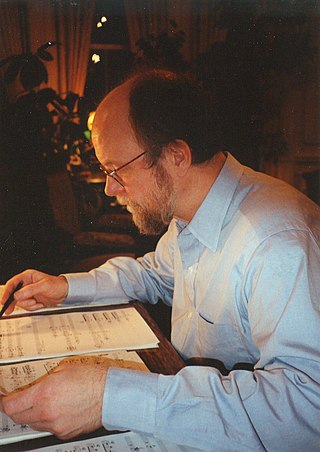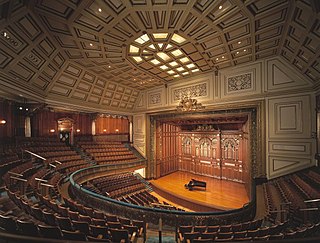Related Research Articles

In music, a quartet is an ensemble of four singers or instrumental performers.

Olivier Eugène Prosper Charles Messiaen was a French composer, organist, and ornithologist. One of the major composers of the 20th century, he was also an outstanding teacher of composition and musical analysis.

The xylorimba is a pitched percussion instrument similar to an extended-range xylophone with a range identical to some 5-octave celestas or 5-octave marimbas, though typically an octave higher than the latter. Despite its name, it is not a combination of a xylophone and a marimba; its name has been a source of confusion, as many composers have called for a 'xylorimba', including Alban Berg, Pierre Boulez and Olivier Messiaen, but for parts requiring only a four-octave xylophone. However, Pierre Boulez wrote for two five-octave xylorimbas in Pli selon pli.

Quatuor pour la fin du Temps, originally Quatuor de la fin du Temps, also known by its English title Quartet for the End of Time, is an eight-movement piece of chamber music by the French composer Olivier Messiaen. It was premiered in 1941. The work is scored for clarinet, violin, cello, and piano; a typical performance of the complete work lasts about 50 minutes. Messiaen wrote the piece while a prisoner of war in German captivity and it was first performed by his fellow prisoners. It is generally considered one of his most important works.

Tōru Takemitsu was a Japanese composer and writer on aesthetics and music theory. Largely self-taught, Takemitsu was admired for the subtle manipulation of instrumental and orchestral timbre. He is known for combining elements of oriental and occidental philosophy and for fusing sound with silence and tradition with innovation.

Charles Peter Wuorinen was an American composer of contemporary classical music based in New York City. He also performed as a pianist and conductor. Wuorinen composed more than 270 works: orchestral music, chamber music, solo instrumental and vocal works, and operas, such as Brokeback Mountain. His work was termed serialist but he came to disparage that idea as meaningless. Time's Encomium, his only purely electronic piece, received the Pulitzer Prize. Wuorinen taught at several institutions, including Columbia University, Rutgers University and the Manhattan School of Music.
A piano quartet is a chamber music composition for piano and three other instruments, or a musical ensemble comprising such instruments. Those other instruments are usually a string trio consisting of a violin, viola and cello.

The Turangalîla-Symphonie is the only symphony by Olivier Messiaen (1908–1992). It was written for an orchestra of large forces from 1946 to 1948 on a commission by Serge Koussevitzky for the Boston Symphony Orchestra. Along with the Quatuor pour la fin du temps, the symphony is one of the composer's most notable works.
Peter Adolf Serkin was an American classical pianist. He won the Grammy Award for Most Promising New Classical Recording Artist in 1966, and he performed globally, known for not only "technically pristine" playing but also a "commitment to contemporary music". He taught at the Curtis Institute of Music, the Juilliard School, Yale University, and Bard College.

Johan Theodorus Loevendie is a Dutch composer and clarinet player.

Jordan Hall is a 1,051-seat concert hall in Boston, Massachusetts, the principal performance space of the New England Conservatory. It is one block from Boston's Symphony Hall. It is the only conservatory building in the United States to be designated a National Historic Landmark. This building is currently under study by the Boston Landmarks Commission for landmark status.

Stalag VIII-A was a German World War II prisoner-of-war camp, located just to the south of the town of Görlitz in Lower Silesia, east of the River Neisse. The location of the camp lies in today's Polish town of Zgorzelec, which lies over the river from Görlitz.
Peter Goddard Lieberson was an American composer of contemporary classical music. His song cycles include two finalists for the Pulitzer Prize for Music: Rilke Songs and Neruda Songs; the latter won the 2008 Grawemeyer Award for Music Composition and both were written for his wife, the mezzo-soprano Lorraine Hunt Lieberson. His three piano concertos were each premiered by the pianist Peter Serkin, with the 1st and 3rd also being Pulitzer finalists.

Bill Douglas is a Canadian musician, composer, pianist, and bassoonist whose works received influence from classical music, jazz, African, Brazilian and Indian music, 1970s funk and many other genres.

Des canyons aux étoiles... is a large twelve-movement orchestral work by the French composer Olivier Messiaen. American Alice Tully commissioned the piece in 1971 to celebrate the bicentenary of the United States Declaration of Independence in 1976.
Ida Kavafian is an American classical violinist and violist.
HenriAkoka was an Algerian Jewish clarinetist.
Gregory S. Haimovsky is a Russian pianist, writer, and pedagogue.
The Dover Quartet is an American string quartet. It was formed at the Curtis Institute of Music in 2008 and its members are graduates of both the Curtis Institute of Music and the Rice University Shepherd School of Music. Its name is taken from the piece Dover Beach by Samuel Barber, who also studied at Curtis. The Dover Quartet was appointed to the faculty of the Curtis Institute of Music as the Penelope P. Watkins ensemble-in-residence in 2020. Additionally, they hold a teaching residency at the Bienen School of Music at Northwestern University.
References
- ↑ Tommasini, Anthony (6 May 2008). "Tashi Quartet Reunites, Celebrates Messiaen Centennial". The New York Times. Retrieved 17 March 2019.